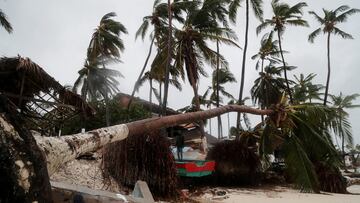Where is the eye of Hurricane Fiona, where is it headed, and when might it end?
Hurricane Fiona intensifies to category 3. Where is the eye of the cyclone, where is it headed, and when might it end? Here the details.

After hitting Puerto Rico and the Dominican Republic on September 18 and 19, respectively, the eye of Hurricane Fiona is now moving towards the small British territory of the Turks and Caicos. Fiona has once again picked up strength, becoming a Category 3 hurricane.
Torrential rains and hurricane-force winds hit Grand Turk Island, the capital of the Caribbean territory, on the morning of this Tuesday, September 20. Because of this, the government of the territory has imposed a curfew, as well as asked residents to flee from “flood-prone areas.”
Hurricane Fiona poured rain on Puerto Rico on Monday, a day after the storm left most of the island without electricity and drinking water.
— The Associated Press (@AP) September 20, 2022
Fiona is now moving towards Turks and Caicos as a Category 3 storm. https://t.co/CPNB6qO8St pic.twitter.com/zSJuWUrNV4
“Storms are unpredictable. Therefore, they must take all precautions to ensure their safety,” Premier Washington Misick said in a statement sent from London, where he is as an invitee to the funeral Queen Elizabeth II.
Hurricane Fiona: Where is it headed and when could it end?
According to the US National Hurricane Center, Fiona could intensify again and reach category 4 on Friday, September 23, as it moves towards Bermuda.
The cyclone is expected to weaken shortly before reaching far eastern Canada over the weekend. However, it will continue to leave heavy rains in its wake.
According to AccuWeather, beaches along the US East Coast could see high waves and minor coastal flooding as the hurricane heads north to Canada.
The impact of Hurricane Fiona on Puerto Rico
As Hurricane Fiona moved through the Dominican Republic and Puerto Rico, failures to protect residents from the storm led to at least five deaths. Puerto Rico, in its entirety, lost electricity during the storm, and with many still waiting to be connected, the death toll could increase.
Related stories
In 2017, after Hurricane Maria hit the island, conditions, including the loss of power across the island, an estimated three thousand people died because they lacked access to basic services. Once again, another severe hurricane has shown the vulnerability the island, its residents, and wildlife face as climate change continues.
Gov. Pedro Pierluisi of Puerto Rico said that as much as 30 inches of rain have fallen in some places and that the island expects to receive even more rain: "Many areas that had never flooded have seen unprecedented water levels." https://t.co/LRWYGlrxQW pic.twitter.com/sjwtQzc3IH
— The New York Times (@nytimes) September 20, 2022
The US Federal government has made some announcements about investments to the island’s energy grid, but it does not appear that any major projects were undertaken between the 2017 disaster and that which occurred this week. During these circumstances, it should be remembered that Puerto Rican people do not have voting representatives on Capitol Hill and, overall, far less power than states to determine their annual budgets. But, after seeing the reports from Jackson, Mississippi, and Flint, Michigan, where residents continue to go without safe drinking water, it has become clear that there exists a severe lack of attention paid to the needs of people with representation in Washington as well.

